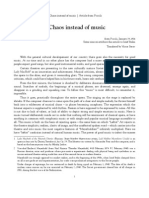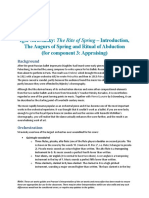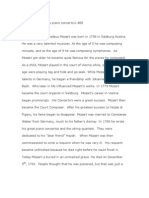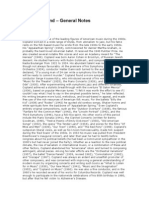Pyotr Ilyich Tchaikovsky
Pyotr Ilyich Tchaikovsky
Uploaded by
Lanja Samal RashidCopyright:
Available Formats
Pyotr Ilyich Tchaikovsky
Pyotr Ilyich Tchaikovsky
Uploaded by
Lanja Samal RashidOriginal Description:
Copyright
Available Formats
Share this document
Did you find this document useful?
Is this content inappropriate?
Copyright:
Available Formats
Pyotr Ilyich Tchaikovsky
Pyotr Ilyich Tchaikovsky
Uploaded by
Lanja Samal RashidCopyright:
Available Formats
Pyotr Ilyich Tchaikovsky
Pyotr Ilyich Tchaikovsky is known as one the most popular Russian composers of all time. With tuneful melodies, impressive harmonies, and colorful orchestration, his music has maintained great appeal and emotional response throughout the years. Tchaikovsky composed 7 symphonies, 11 operas, 3 ballets, 5 suites, 3 piano concertos, a violin concerto, 11 overtures, 4 cantatas, 20 choral works, 3 string quartets, a string sextet, and more than 100 songs and piano pieces during his lifetime, thus making his mark as one of the most admired composers of the Romantic Era. Tchaikovsky was born on May 7th 1840 in Votkinsk, a small town in a former province of Vyatka in the Russian Empire. His father, Ilya Petrovich Tchaikovsky, was a successful mining engineer and worked as a lieutenant colonel in the Department of Mines. His mother, Alexandra, the second of Ilya's three wives, was 18 years younger than her husband. Tchaikovsky had four brothers, a sister, and a half-sister from his father's first marriage. Fanny Drbach, a French governess employed by his family, taught Pyotr Tchaikovsky to be fluent in French and German by the age of six. In fact, she also saved much of Tchaikovsky's musical works from this period, which formed his earliest known compositions. Tchaikovsky started taking piano lessons at the age of five. Though his parents were firstly supportive, his family decided to send Tchaikovsky to the Imperial School of Jurisprudence in Saint Petersburg in 1850 for a more promising future. However, Tchaikovsky's parting from his mother to attend boarding school and her untimely death from cholera in 1854 caused a severe emotional trauma that stayed with him for most of his life. Tchaikovsky's father sent him back to school so that his studies would keep him engaged. He was so traumatized by his mothers death that he responded by turning to music. It was at this time that he made his first serious efforts as a composer, writing a waltz in her memory. In 1855, Peter's father asked a well-known German piano teacher to encourage his son's interest in music. However, when Peter's father asked about his son's musical potential, his teacher wrote that nothing indicated he would be a fine composer or performer. His father asked Peter to complete his course of study and then pursue a post in the Ministry of Justice. He did as he was asked, though his interest in music never left him.
In 1861, Tchaikovsky heard about classes being offered by the Russian Musical Society. He promptly began his studies. In the following year, Tchaikovsky followed his teacher to the St. Petersburg Conservatory where he accepted a post. It was at the conservatory that he met and studied with Anton Rubinstein, director and founder of the Conservatory. Rubinstein was impressed with Tchaikovsky's talent. . In addition to learning while at the conservatory, Tchaikovsky gave private lessons to other students. In 1863, he moved to Moscow, where he became a professor of harmony at the Moscow Conservatory. Rubinstein's Western musical orientation brought him into opposition with the nationalistic group of musicians known as The Five. As Tchaikovsky was Rubinstein's best-known pupil, he became a target for the group, especially for Csar Cui. Cui's criticisms began with an intense review of a cantata Tchaikovsky had written as his graduation exercise from the Conservatory. In 1868, at the age of 28, Tchaikovsky met the Belgian soprano Dsire Artt, they became lovesick, and were engaged to be married. He dedicated his Romance in F minor for piano, Op. 5, to her. However, on September 15, 1869, without any communication with Tchaikovsky, Artt married a member of her company, the Spanish baritone Mariano Padilla y Ramos. They met on a handful of later occasions, and in October 1888 he wrote Six French Songs, Op. 65, for her, in response to her request for a single song. Tchaikovsky later claimed she was the only woman he ever loved. In 1869 Tchaikovsky composed his first recognized masterpiece, the Overture-Fantasy Romeo and Juliet. Tchaikovsky was deeply inspired by Shakespeare's writing, and in later years composed other works for The Tempest and Hamlet. Till 1878, Tchaikovsky combined his professorial duties with music criticism while continuing to compose. Some of his best-known works from this period include the First Piano Concerto, the Variations on a Rococo Theme for violoncello and orchestra, the Little Russian and Fourth Symphonies, the ballet Swan Lake and the opera Eugene Onegin. The First Piano Concerto suffered an initial rejection by Anton Rubinstein's brother Nikolai, even though he eventually supported the work. The work was later premiered in Boston in October 1875, played by Hans von Blow, whose pianism had impressed Tchaikovsky during an appearance in Moscow in March 1874. In Moscow, teaching with Nikolai Rubinstein, Tchaikovsky gained his first taste of famed appreciation. Introduced into the Artistic Circle, a club founded by Rubinstein, Tchaikovsky enjoyed a sense of social celebrity status among friends and fellow artists. However, over a five-year period, Tchaikovsky became frustrated with teaching and found himself struggling financially. He gradually moved away from Rubinstein, to maintain his independence from Rubinstein's popular reputation. While the move to Moscow was bittersweet, filled with
friendship, jealousy, and inner struggles, it was successful from a professional point of view. Tchaikovsky's musical works were frequently performed, with few delays between their composition and first performances, and the publication (after 1867) of songs and piano music for the home market helped bolster the composer's popularity. In April 1877 Tchaikovsky's favorite pupil, Vladimir Shilovsky, married suddenly. Shilovsky's wedding may in turn have spurred Tchaikovsky to consider such a step himself.[ He declared his intention to marry in a letter to his brother. Then Tchaikovsky's got married to one of his former composition students, Antonina Miliukova. The brief time with his wife drove him to an emotional crisis, which was followed by a stay in Clarens, Switzerland, for rest and recovery. They remained legally married but never lived together again nor had any children, though she later gave birth to three children by another man. Tchaikovsky's marital misfortune may have forced him to face the full truth concerning his sexuality. He apparently never again considered matrimony as a camouflage or escape, nor considered himself capable of loving women in the same manner as men. Nadezhda von Meck was the wealthy widow of a Russian railway industrialist and an influential patron of the arts. Having already heard some of Tchaikovsky's work, she was encouraged by Kotek to commission some chamber pieces from him. Her support became an important element in Tchaikovsky's life; she eventually paid him an annual subsidy of 6,000 rubles, which made it possible for him to resign from the Moscow Conservatory in October 1878 at the age of 38, and concentrate on composition. With von Meck's patronage came a relationship that, at her insistence, was mainly through letters, she insisted that they were never to meet face to face. They exchanged well over 1,000 letters between 1877 and 1890. In these letters Tchaikovsky was more open about much of his life and his creative processes than he had been to any other person. Tchaikovsky died in Saint Petersburg on November 6, 1893, nine days after the premiere of his Sixth Symphony, the Pathtique. Though only 53 years old, he lived a long life compared to many Russian 19th century composers. He was interred in Tikhvin Cemetery at the Alexander Nevsky Monastery. Because of the Pathtique's formal innovation and the overwhelming emotional content of its outer movements, the work was received by the public with silent incomprehension at its first performance. The second performance, led by Npravnk, took place 20 days later at a memorial concert and was much more favorably received. The Pathtique has since become one of Tchaikovsky's best known works. Tchaikovsky's death has traditionally been attributed to cholera, most probably contracted through drinking contaminated water several days earlier.
You might also like
- Scrub Cap With Ponytail - Written InstructionsDocument8 pagesScrub Cap With Ponytail - Written InstructionsAna GuevaraNo ratings yet
- Composers During Renaissance PeriodDocument9 pagesComposers During Renaissance PeriodMariacherry Martin100% (1)
- Muck Globe MagazineDocument14 pagesMuck Globe MagazineAlexandru Pătrașcu100% (1)
- Symphonie Fantastique (Fifth Movement) AnalysisDocument10 pagesSymphonie Fantastique (Fifth Movement) Analysissmooth writerNo ratings yet
- Preface: by Gennadi Moyseyevich Tsipin Translated Beatrice FrankDocument16 pagesPreface: by Gennadi Moyseyevich Tsipin Translated Beatrice FrankAmy HuynhNo ratings yet
- Boileau, Nicholas - Selected PoemsDocument82 pagesBoileau, Nicholas - Selected PoemsVinícius Pessoa100% (1)
- Music of The Romantic Era PDFDocument7 pagesMusic of The Romantic Era PDFQuynh NguyenNo ratings yet
- Pyotr Ilyich TchaikovskyDocument2 pagesPyotr Ilyich Tchaikovskyrayche72No ratings yet
- TchaikovskyDocument9 pagesTchaikovskyapi-253195322No ratings yet
- The Life and Music of Peter Ilych TchaikovskyDocument14 pagesThe Life and Music of Peter Ilych TchaikovskyVenice EscolarNo ratings yet
- Pyotr Ilyich TchaikovskyDocument4 pagesPyotr Ilyich TchaikovskyLanja Samal RashidNo ratings yet
- Balakirev, Tchaikovsky and NationalismDocument16 pagesBalakirev, Tchaikovsky and Nationalismjordi_f_sNo ratings yet
- Shostakovich Piano Trio No 2 in E MinorDocument1 pageShostakovich Piano Trio No 2 in E MinorEduardo MoreiraNo ratings yet
- Group 4 SHORT STORYDocument20 pagesGroup 4 SHORT STORYHosana RiepNo ratings yet
- Wilhelm Richard Wagner (Document2 pagesWilhelm Richard Wagner (Teodora UdrescuNo ratings yet
- Further ReadingDocument13 pagesFurther ReadingMatthew PalfreymanNo ratings yet
- Russian Ballet by The Age of PetipaDocument13 pagesRussian Ballet by The Age of PetipaAnh NguynNo ratings yet
- Berlioz: Symphonie Fantastique: Movement, I (For Component 3: Appraising)Document7 pagesBerlioz: Symphonie Fantastique: Movement, I (For Component 3: Appraising)Amir Sanjary ComposerNo ratings yet
- Beethoven and French SchoolDocument20 pagesBeethoven and French SchoolYBNo ratings yet
- Neo ClassicismDocument14 pagesNeo ClassicismJohndale AguilarNo ratings yet
- Classical PeriodDocument20 pagesClassical PeriodBuho MelomanoNo ratings yet
- Solomon Beethoven 9Document22 pagesSolomon Beethoven 9JayYangy100% (1)
- Frédéric Chopin (1810-1849)Document3 pagesFrédéric Chopin (1810-1849)Margie ManzanoNo ratings yet
- Mendelssohn Italian Symphony No4Document8 pagesMendelssohn Italian Symphony No4alison ChapmanNo ratings yet
- Winds and Piano NotesDocument4 pagesWinds and Piano NotesPaul NohNo ratings yet
- Arnold SchoenbergDocument36 pagesArnold SchoenbergAndrew A. FaddoulNo ratings yet
- Instrumental Music in The The 18th Century... 1Document7 pagesInstrumental Music in The The 18th Century... 1nirpeerNo ratings yet
- Chaos Instead of MusicDocument2 pagesChaos Instead of MusicAndré Kugland100% (1)
- Extended Upbeats in The Classical Minuet InteractDocument34 pagesExtended Upbeats in The Classical Minuet InteractBrianMoseleyNo ratings yet
- Beethoven: Classic or RomanticDocument7 pagesBeethoven: Classic or Romanticco12451No ratings yet
- History of Opera Final VersionDocument55 pagesHistory of Opera Final VersionPatrick AskinNo ratings yet
- Renaissance Music Exam2Document2 pagesRenaissance Music Exam2lennypopNo ratings yet
- The Hidden Driver: Climate Change and Migration in Central America's Northern TriangleDocument23 pagesThe Hidden Driver: Climate Change and Migration in Central America's Northern TriangleThe American Security ProjectNo ratings yet
- Music of The Romantic Period G9Document11 pagesMusic of The Romantic Period G9JUDITH M. MABAONo ratings yet
- Symphonie FantastiqueDocument29 pagesSymphonie FantastiqueUkkashah ShaikhNo ratings yet
- A Level Stravinsky Set Work Support GuideDocument6 pagesA Level Stravinsky Set Work Support GuideDora GaitanoviciNo ratings yet
- Dmitri Shostakovich - PresentationDocument14 pagesDmitri Shostakovich - Presentationapi-270453251No ratings yet
- Syllabus - ANTH 222 W20241Document12 pagesSyllabus - ANTH 222 W20241datid35529No ratings yet
- Musical NationalismDocument38 pagesMusical NationalismLuis Noel Antezana ChinchillaNo ratings yet
- BACH's NoteDocument16 pagesBACH's NoteIvana HalingkarNo ratings yet
- Chapter Four - French Baroque Opera - Lully and RameauDocument3 pagesChapter Four - French Baroque Opera - Lully and RameauDiana Alejandra Trujillo MartínezNo ratings yet
- Romantic Music Pre TestDocument1 pageRomantic Music Pre TestAmiel MaldonadoNo ratings yet
- Unit 5 - The Second Generation of Romantic Poetry - Kérchy - EFOPDocument17 pagesUnit 5 - The Second Generation of Romantic Poetry - Kérchy - EFOPKamillaJuhászNo ratings yet
- Music History 9Document20 pagesMusic History 9Pat P. MonteNo ratings yet
- K.488 EssayDocument4 pagesK.488 Essayilovepink8No ratings yet
- Chapter 9 Cliff Notes PDFDocument5 pagesChapter 9 Cliff Notes PDFAriel GoldbergNo ratings yet
- James Joyce - Ulysses - Study Guide - 60 PagesDocument56 pagesJames Joyce - Ulysses - Study Guide - 60 PagesClaudia AimeeNo ratings yet
- Mendelssohn PaperDocument11 pagesMendelssohn Paperapi-406972706No ratings yet
- Violin Concerto in A Minor Aqa GuideDocument4 pagesViolin Concerto in A Minor Aqa GuideO ThomasNo ratings yet
- Alexander Scriabin NotesDocument1 pageAlexander Scriabin NotesGeorgia ZafeiropoulouNo ratings yet
- Source 04Document118 pagesSource 04Ezequiel Eduardo100% (1)
- Aaron Copland - General NotesDocument2 pagesAaron Copland - General NotesJohnny WattNo ratings yet
- Scriabin and His Sonata in F Sharp MajorDocument2 pagesScriabin and His Sonata in F Sharp MajorSeunghyun RyuNo ratings yet
- Stories of The Wagner Opera by Guerber, H. A. (Hélène Adeline), 1859-1929Document75 pagesStories of The Wagner Opera by Guerber, H. A. (Hélène Adeline), 1859-1929Gutenberg.orgNo ratings yet
- Claude DebussyDocument9 pagesClaude DebussyMae Jane AguilarNo ratings yet
- César Franck (1822 - 1890)Document12 pagesCésar Franck (1822 - 1890)Dung Lê Phạm MỹNo ratings yet
- Giovanni Pierluigi Da PalestrinaDocument1 pageGiovanni Pierluigi Da PalestrinaSherryl ZamonteNo ratings yet
- Alban Berg's Sieben Frühe LiederDocument6 pagesAlban Berg's Sieben Frühe LiederskiprydooNo ratings yet
- Music of The Medieval PeriodDocument33 pagesMusic of The Medieval PeriodEric Jordan ManuevoNo ratings yet
- Neoclassical Music Composers and Their WorksDocument2 pagesNeoclassical Music Composers and Their WorksIrishman70880% (5)
- 28-32 Pentatonic Scale-2Document6 pages28-32 Pentatonic Scale-2creativewebcrNo ratings yet
- Product Description 4283241Document17 pagesProduct Description 4283241Bs Barbarian100% (1)
- Taller de InglesDocument2 pagesTaller de InglesYeferson Correa RojasNo ratings yet
- Gabriel Kruether: Soumik Das-Iihm16Kol213 Roni Das - Iihm16Kol214 Akashdeepdutta - Iihm16Kol217Document20 pagesGabriel Kruether: Soumik Das-Iihm16Kol213 Roni Das - Iihm16Kol214 Akashdeepdutta - Iihm16Kol217Roni DasNo ratings yet
- Music of Memory Nicolas MawDocument77 pagesMusic of Memory Nicolas MawRobert BekkersNo ratings yet
- Digital Booklet - God Forgives, I Don'tDocument7 pagesDigital Booklet - God Forgives, I Don'tChristian CamposNo ratings yet
- PreSonus StudioLive 16.4.2Document8 pagesPreSonus StudioLive 16.4.2Ninoslav KosticNo ratings yet
- Time Out Budapest, November 2012Document68 pagesTime Out Budapest, November 2012Scott Alexander YoungNo ratings yet
- Ariana Villanueva ResumeDocument1 pageAriana Villanueva Resumeariana villanuevaNo ratings yet
- Journey To The Center of The Earth. Word SearchDocument2 pagesJourney To The Center of The Earth. Word Searchwww.getenglishlessons.com100% (5)
- Purposive Communication 10-1Document11 pagesPurposive Communication 10-1Kenji XenonNo ratings yet
- 5-Non Restrictive Clause ClassworkDocument3 pages5-Non Restrictive Clause ClassworkAmir NagyNo ratings yet
- References For Paintings: Mark Tansey: Visions and RevisionsDocument4 pagesReferences For Paintings: Mark Tansey: Visions and RevisionsCintia Gutierrez ReyesNo ratings yet
- 5 Dollar Dinners CookbookDocument18 pages5 Dollar Dinners CookbookSara LimNo ratings yet
- Striker:: Speed and QuicknessDocument4 pagesStriker:: Speed and QuicknessMatīss ČirkunovsNo ratings yet
- English 3 Future WillDocument9 pagesEnglish 3 Future WillBrayan EduardoNo ratings yet
- CD 423 Data SheetDocument2 pagesCD 423 Data Sheetcip2009No ratings yet
- L2V4bGlicmlzL2R0bC9kM18xL2FwYWNoZV9tZWRpYS8yMzc4Nzcx PDFDocument68 pagesL2V4bGlicmlzL2R0bC9kM18xL2FwYWNoZV9tZWRpYS8yMzc4Nzcx PDFmagicman100% (1)
- Sharon Cuneta: Sharon Gamboa Cuneta-Pangilinan (Born January 6, 1966) Is A Filipino Actress, Singer andDocument6 pagesSharon Cuneta: Sharon Gamboa Cuneta-Pangilinan (Born January 6, 1966) Is A Filipino Actress, Singer andsad but cuteNo ratings yet
- Exercise Program DesignDocument17 pagesExercise Program DesignMark Joshua MandaniNo ratings yet
- 05-05-17 EditionDocument31 pages05-05-17 EditionSan Mateo Daily JournalNo ratings yet
- Post Test in MilDocument3 pagesPost Test in MilRuAnn GuillamonNo ratings yet
- Exception Report TORRES-PC 10-23-11 17.57.30 ExceptionDocument5 pagesException Report TORRES-PC 10-23-11 17.57.30 ExceptionmioltorNo ratings yet
- Error CorrectionDocument4 pagesError CorrectionĐỗ Thùy TrangNo ratings yet
- Review 4esoDocument5 pagesReview 4esoMaria Martos AlcarazNo ratings yet
- Purchase Order: Vendor Details Consignee Bill To Purchase Order Document No Date Vendor No. Currency Buyer Delivery DateDocument15 pagesPurchase Order: Vendor Details Consignee Bill To Purchase Order Document No Date Vendor No. Currency Buyer Delivery DateSanjeevNo ratings yet
- Electronic Reservation Slip (ERS) : 2616264571 12626/kerala Express Ac 2 Tier Sleeper (2A)Document2 pagesElectronic Reservation Slip (ERS) : 2616264571 12626/kerala Express Ac 2 Tier Sleeper (2A)VeldiSrinivasNo ratings yet
- Ca2 Phy110Document6 pagesCa2 Phy110Mohammad YusufNo ratings yet
- Initial Router Installation and ConfigurationDocument3 pagesInitial Router Installation and ConfigurationJulio JordanNo ratings yet

























































































